Tejaswini Medi
TRIX- Trading Adversarial Fairness via Mixed Adversarial Training
Jul 10, 2025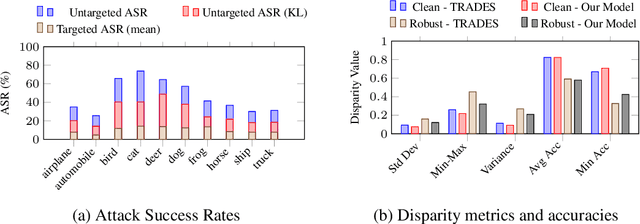


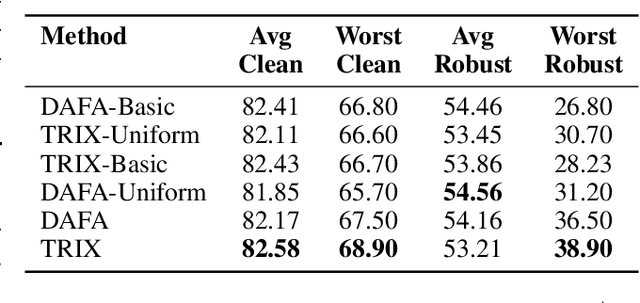
Abstract:Adversarial Training (AT) is a widely adopted defense against adversarial examples. However, existing approaches typically apply a uniform training objective across all classes, overlooking disparities in class-wise vulnerability. This results in adversarial unfairness: classes with well distinguishable features (strong classes) tend to become more robust, while classes with overlapping or shared features(weak classes) remain disproportionately susceptible to adversarial attacks. We observe that strong classes do not require strong adversaries during training, as their non-robust features are quickly suppressed. In contrast, weak classes benefit from stronger adversaries to effectively reduce their vulnerabilities. Motivated by this, we introduce TRIX, a feature-aware adversarial training framework that adaptively assigns weaker targeted adversaries to strong classes, promoting feature diversity via uniformly sampled targets, and stronger untargeted adversaries to weak classes, enhancing their focused robustness. TRIX further incorporates per-class loss weighting and perturbation strength adjustments, building on prior work, to emphasize weak classes during the optimization. Comprehensive experiments on standard image classification benchmarks, including evaluations under strong attacks such as PGD and AutoAttack, demonstrate that TRIX significantly improves worst-case class accuracy on both clean and adversarial data, reducing inter-class robustness disparities, and preserves overall accuracy. Our results highlight TRIX as a practical step toward fair and effective adversarial defense.
Towards Class-wise Robustness Analysis
Nov 29, 2024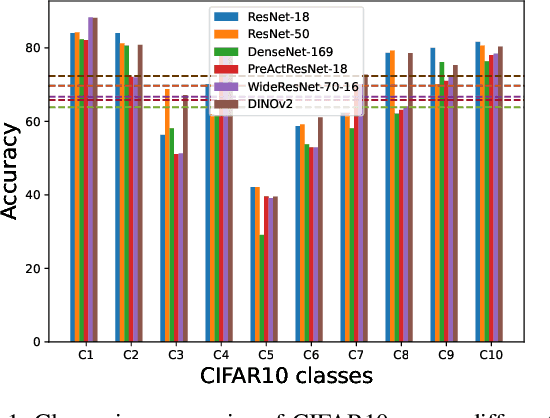
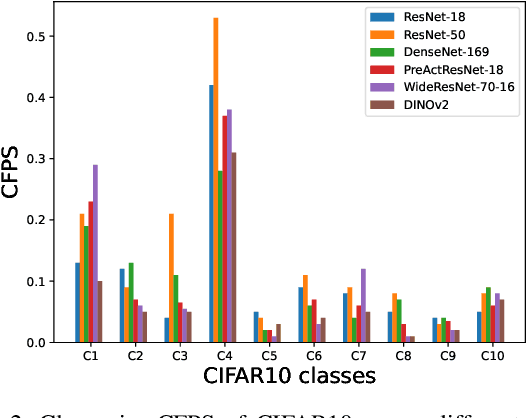
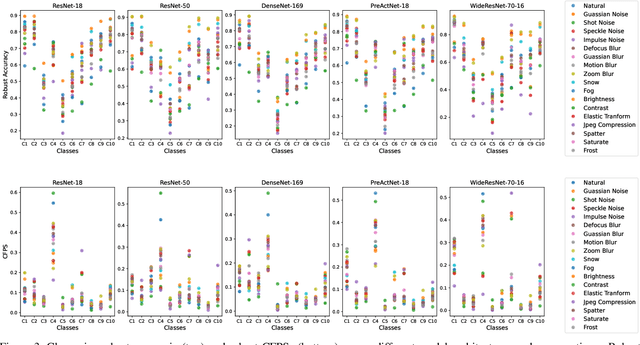
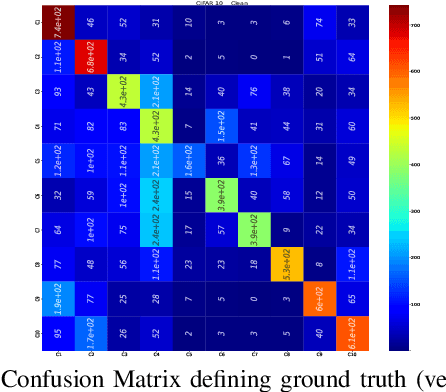
Abstract:While being very successful in solving many downstream tasks, the application of deep neural networks is limited in real-life scenarios because of their susceptibility to domain shifts such as common corruptions, and adversarial attacks. The existence of adversarial examples and data corruption significantly reduces the performance of deep classification models. Researchers have made strides in developing robust neural architectures to bolster decisions of deep classifiers. However, most of these works rely on effective adversarial training methods, and predominantly focus on overall model robustness, disregarding class-wise differences in robustness, which are critical. Exploiting weakly robust classes is a potential avenue for attackers to fool the image recognition models. Therefore, this study investigates class-to-class biases across adversarially trained robust classification models to understand their latent space structures and analyze their strong and weak class-wise properties. We further assess the robustness of classes against common corruptions and adversarial attacks, recognizing that class vulnerability extends beyond the number of correct classifications for a specific class. We find that the number of false positives of classes as specific target classes significantly impacts their vulnerability to attacks. Through our analysis on the Class False Positive Score, we assess a fair evaluation of how susceptible each class is to misclassification.
3D-WAG: Hierarchical Wavelet-Guided Autoregressive Generation for High-Fidelity 3D Shapes
Nov 28, 2024



Abstract:Autoregressive (AR) models have achieved remarkable success in natural language and image generation, but their application to 3D shape modeling remains largely unexplored. Unlike diffusion models, AR models enable more efficient and controllable generation with faster inference times, making them especially suitable for data-intensive domains. Traditional 3D generative models using AR approaches often rely on ``next-token" predictions at the voxel or point level. While effective for certain applications, these methods can be restrictive and computationally expensive when dealing with large-scale 3D data. To tackle these challenges, we introduce 3D-WAG, an AR model for 3D implicit distance fields that can perform unconditional shape generation, class-conditioned and also text-conditioned shape generation. Our key idea is to encode shapes as multi-scale wavelet token maps and use a Transformer to predict the ``next higher-resolution token map" in an autoregressive manner. By redefining 3D AR generation task as ``next-scale" prediction, we reduce the computational cost of generation compared to traditional ``next-token" prediction models, while preserving essential geometric details of 3D shapes in a more structured and hierarchical manner. We evaluate 3D-WAG to showcase its benefit by quantitative and qualitative comparisons with state-of-the-art methods on widely used benchmarks. Our results show 3D-WAG achieves superior performance in key metrics like Coverage and MMD, generating high-fidelity 3D shapes that closely match the real data distribution.
FAIR-TAT: Improving Model Fairness Using Targeted Adversarial Training
Oct 30, 2024



Abstract:Deep neural networks are susceptible to adversarial attacks and common corruptions, which undermine their robustness. In order to enhance model resilience against such challenges, Adversarial Training (AT) has emerged as a prominent solution. Nevertheless, adversarial robustness is often attained at the expense of model fairness during AT, i.e., disparity in class-wise robustness of the model. While distinctive classes become more robust towards such adversaries, hard to detect classes suffer. Recently, research has focused on improving model fairness specifically for perturbed images, overlooking the accuracy of the most likely non-perturbed data. Additionally, despite their robustness against the adversaries encountered during model training, state-of-the-art adversarial trained models have difficulty maintaining robustness and fairness when confronted with diverse adversarial threats or common corruptions. In this work, we address the above concerns by introducing a novel approach called Fair Targeted Adversarial Training (FAIR-TAT). We show that using targeted adversarial attacks for adversarial training (instead of untargeted attacks) can allow for more favorable trade-offs with respect to adversarial fairness. Empirical results validate the efficacy of our approach.
FullFormer: Generating Shapes Inside Shapes
Mar 20, 2023Abstract:Implicit generative models have been widely employed to model 3D data and have recently proven to be successful in encoding and generating high-quality 3D shapes. This work builds upon these models and alleviates current limitations by presenting the first implicit generative model that facilitates the generation of complex 3D shapes with rich internal geometric details. To achieve this, our model uses unsigned distance fields to represent nested 3D surfaces allowing learning from non-watertight mesh data. We propose a transformer-based autoregressive model for 3D shape generation that leverages context-rich tokens from vector quantized shape embeddings. The generated tokens are decoded into an unsigned distance field which is rendered into a novel 3D shape exhibiting a rich internal structure. We demonstrate that our model achieves state-of-the-art point cloud generation results on popular classes of 'Cars', 'Planes', and 'Chairs' of the ShapeNet dataset. Additionally, we curate a dataset that exclusively comprises shapes with realistic internal details from the `Cars' class of ShapeNet and demonstrate our method's efficacy in generating these shapes with internal geometry.
 Add to Chrome
Add to Chrome Add to Firefox
Add to Firefox Add to Edge
Add to Edge